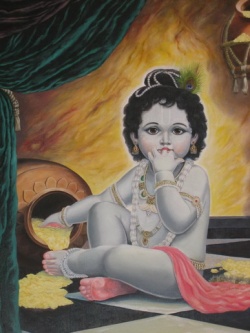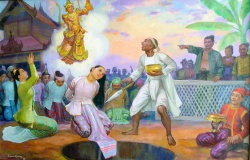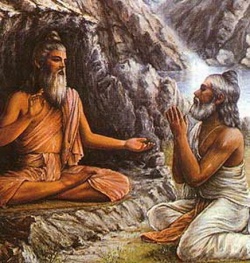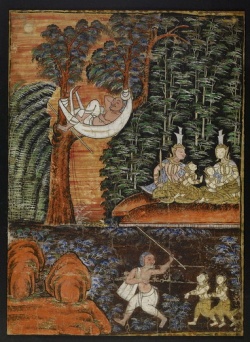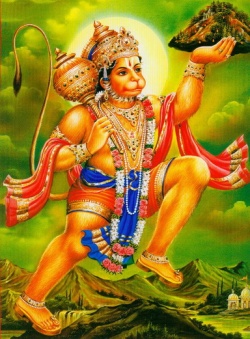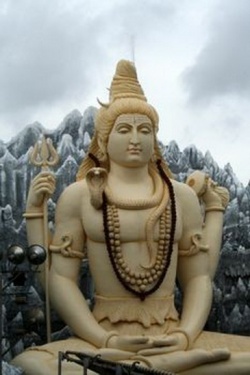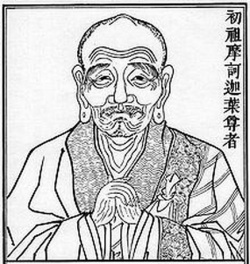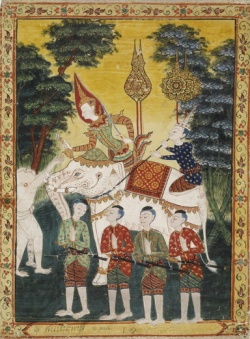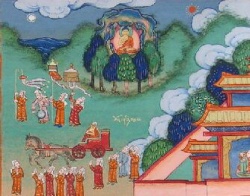Non-cognition and the third pramāṇa
In the history of Indian philosophy, we can identify three major figures who contributed to the theory of non-cognition. These are the Mīmāṃsāka Kumārila, the Buddhist Īśvarasena and the latter’s student Dharmakīrti. Whereas we have a large amount of materials that attest the thought of Kumārila and Dharmakīrti, sources that allow us to determine Īśvarasena’s ideas are very limited in number and are only indirect, as none of his works has survived.
The present paper will discuss some concepts and materials that may be linked to Īśvarasena’s ideas. These include the concept of feiliang 非量 as found in the writings of Dharmapāla, Asvabhāva, Jinaputra and their Chinese counterparts, and apramāṇatā (or apramāṇatva), as found in the works of Dharmakīrti and his commentators. I shall demonstrate that the two con- cepts in many ways mirror the theory of three pramāṇas, proposed by Īśvarasena.
As most of these materials are from the sixth to eighth century, they are extremely helpful for clarifying the early development of the theory of non-cognition and the interactions between the three figures mentioned above. This is especially true when they are compared with post- Dharmakīrtian Indian commentaries and later Tibetan sources, which constitute the main focus of research for many scholars. In this paper, the author hopes to fill gaps in our understanding of the early development of this theory, and to respond to Prof. Steinkellner’s call, made more than a decade ago, for such a study.
1. A third pramāṇa
In a recent article, Birgit Kellner identified three major thinkers who advanced the theory of non-cognition in the history of Indian philosophy.1 All of them, curiously, were active around the seventh century. The first is Kumārila, a Bhaṭṭa Mīmāṃsāka, who left us the voluminous Ślokavārttika, which contains a chapter on absence (abhāva) – presumably the earliest syste- matic treatment of such a concept in the history of Indian philosophy.2 This chapter in turn was criticized by the Buddhist scholar Śāntarakṣita in the eighth century. Kellner (1997a) and
1 See Kellner 2003: 121.
2 Based on the available sources, we can roughly assume that Kumārila was an elder contemporary of Dharmakīrti. Īśvarasena, being the teacher of Dharmakīrti, was certainly earlier than the latter. But we do not know for sure whether he was earlier than Kumārila, or whether he was influenced by the latter. Neither can we sufficiently explain why the issue of non-cognition attracted so much attention in the seventh century.
Taber (2001) have conducted careful studies of the relevant passages in Kumārila’s Ślokavārttika and Tantravārttika, as well as of some fragments of his lost Bṛhaṭṭīkā that appear to have been preserved in Śāntarakṣita’s Tattvasaṅgraha. Kumārila, a non-Buddhist and vocal critic of Dignāga, was obviously not bound to the latter’s endorsement of only two means of knowledge (pramāṇa), i.e., perception (pratyakṣa) and inference (anumāna). In contrast, he proposed six means of knowledge, namely perception, inference, verbal testimony (śabda), analogy (upamāna), presumption (arthāpatti) and absence (abhāva).3
The second figure is the Buddhist philosopher Dharmakīrti, who developed the concept of anupalabdhi in his various works, and left us with the most sophisticated account of non-cogni- tion in the history of Buddhism. Dharmakīrti strictly follows Dignāga in admitting no more than two means of knowledge. In contrast to the Naiyāyikas, who hold that absence is known through perception, he insists that it is known through inference. In Dharmakīrti’s view, the fact that ‘there is no pottery on the table’ is known through an inferential judgment that is based on the perception of an empty table instead of a table with pottery. He further under- stands non-cognition (anupalabdhi) as one of the three types of evidence (hetu) that ensure sound inferences, and classifies it into various types, in his Nyāyabindu up to eleven.4
Various scholars have conducted detailed studies of this concept in the works of Dharmakīrti and post-Dharmakīrti commentators, most notably Kellner (1997a, 1997b, 1999, 2001, 2003). It appears that Dharmakīrti did not develop his theory of non-cognition from scratch. Most probably, he was responding to the third figure, i.e., his teacher Īśvarasena, who, in contrast to the other two figures, unfortunately left us no writings, although fragments of his ideas can be found in Dharmakīrti’s works. According to Steinkellner (1966) and Katsura (1992), one salient feature of Īśvarasena’s view on non-cognition is that he takes it as a separate pramāṇa over and above perception and inference, which is exactly the view that Dharmakīrti went to great lengths to refute. Because of Dharmakīrti’s great efforts and subsequent influence, we do not see any evidence that Īśvarasena’s somewhat ‘heretic’ view was held by post-Dharmakīrti Indian Buddhist philosophers. Therefore, we know very little about this third pramāṇa except that it is referred to as the mere absence of cognition (uplabdhyabhāvamātra) or mere non- perception (adarśanamātra).
Katsura (1992) and Yaita (1984, 1985b) identified some sections of Dignāga’s works that mark an early development of this theory. According to Katsura (1992), the fact that Dignāga knew about the idea of non-cognition is indicated in two passages, in chapter five of the Pra- māṇasamuccayavṛtti and in the Nyāyamukha respectively. The first passage is in a context of a discussion of Dignāga’s philosophy of language – the apoha theory, where the term adarśanamātra is used to state that the negative concomitance (vyatireka) can be determined on the basis of mere non-perception (adarśanamātreṇa). This could be the basis on which Īśvarasena developed his own concept of mere non-perception. The second passage, on the other hand, contains the term anupalabdhi, which was later commonly used by Dharmakīrti.
3 This sixfold classification of pramāṇa was known to the seventh century Chinese scholar Kuiji 窺基, who rendered the sixth pramāṇa non-cognition as wu-ti-liang 無體量; see Taisho 1840: 95b18.
4 The other two types of evidence are effect (kārya) and identity (svabhāva), both of which guarantee the necessity of affirmative judgments.
This passage, in turn, is referred to and discussed at length in Dharmakīrti’s Pramāṇavārttika- svavṛtti.
It seems that no further progress has been made to trace pre-Dharmakīrti sources on non- cognition, although, as pointed out by Steinkellner (1992: 403 n.27), there is a strong need for such a study. Somewhat surprisingly, little attention has been paid to the many extant Chinese sources that make mention of three pramāṇas. The predominance of three pramāṇas in China owes to the influence of pre-Dignāga works on Buddhist logic. These works, attributed to Asaṅga and Vasubandhu, usually admit more than two pramāṇas, the third of which, however, is given as āgama or śabda. When Xuanzang 玄奘 and others introduced Dignāga’s works on logic to China in the seventh century, scholars started to realize that āgama or śabda should not stand out as an independent pramāṇa. Thus there was a movement to recognize only two kinds of pramāṇas, and this position can be seen, most naturally, in the commentarial tradition of Dignāga’s works.
But soon after or around this time, a new set of three pramāṇas emerged. In this set, besides the usual members of perception and inference, we find a third one called feiliang, or literally non-pramāṇa. Even without looking closer at the details, one might suspect that this third pramāṇa is related to Īśvarasena’s ideas. We are thus given a gleam of hope that we may be able to find the traces of this lost tradition.
2. feiliang
As a pramāṇa which is listed together with perception and inference, feiliang needs some explanation. fei 非 denotes a sense of negation, meaning ‘no’ or ‘non-;’ liang 量 literally means ‘to measure’ and is used to translate the Sanskrit term pramāṇa, which is a technical term in Buddhist epistemology and logic. When used in a non-technical sense, feiliang means immeasurable or unlimited, and its Sanskrit equivalent is apramāṇa. Even in its technical usage, the term feiliang could have two meanings. The first simply indicates a negation of being a pramāṇa, thus meaning ‘not a pramāṇa,’ and its Sanskrit equivalent is also apramāṇa. This usage is frequently seen in the works of Dharmakīrti; for instance in the Pramāṇavārttika (PV) I.335, III.89, IV.3 and IV.237.5
The other meaning of feiliang is found in the sources that we will discuss in section 5, where it is listed as a third pramāṇa over and above perception and inference. At this point, we cannot be sure about its Sanskrit equivalent, as most of the sources for this usage are only extant in Chinese. As a matter of fact, Buddhist scholars in East Asia have never attempted to make a connection between this concept and its likely Indian sources, and have instead followed the traditional view of Kuiji, who defines feiliang in terms of pseudo-perception (pratyakṣābhāsa) and pseudo-inference (anumānābhāsa).
Pseudo-perception here refers to those types of cognition, such as recollection, erroneous cog- nition, desire, etc., that are not considered valid means of knowledge, but only appear as per- ceptions (pratyakṣa-ābhāsa). Post-Dignāga commentators led extensive discussions on the causes of pseudo-perception; some held that it is due to the interference of mental conscious-
5 According to Miyasaka 1971/2.
ness, which is capable of conceptual construction, in the functioning of the sense conscious- ness, while others saw it to be caused by defects in the sense organs themselves.6 Pseudo-infe- rence refers to an inference that violates the rules for proper inference. Both pseudo-perception and pseudo-inference are considered mistaken, and thus called feiliang – non-pramāṇa or not a pramāṇa. ‘Non-’ or ‘not’ here implies a sense of ‘not being (a proper x)’ or ‘mistaken.’
But this understanding is not applicable to feiliang when it is listed as one of the three pramā- ṇas, where it is considered a valid means of knowledge rather than a mistaken cognition. More importantly, in Sanskrit and Tibetan sources, we do not find a concept like non-pramāṇa that covers the scope of pseudo-perception and pseudo-inference and is listed as a third pramāṇa. It is true that in Śaṅkarasvāmin’s Nyāyapraveśa, pseudo-perception and pseudo-inference are listed almost immediately after perception and inference have been defined.7 In his com- mentary on this very text, Kuiji elaborates the view that both pseudo-perception and pseudo- inference are included under the concept of feiliang, which is therefore understood to be parallel to perception and inference. He says: “Both pseudo-perception and pseudo-inference are covered by feiliang. Therefore, perception is included in neither inference nor feiliang, and inference is not included in feiliang either.”8
Although Kuiji offered us the most explicit definition of feiliang, one that came to dominate the later history of East Asian Buddhism, he was not the first one to come up with this concept. One of the sources he relied on could have been the *Vijñaptimātratāsiddhi, a collection of commentaries on Vasubandhu’s Triṃśikā by ten Indian scholars including Dharmapāla. In this text, the term feiliang appears three times in the context of a discussion of Dharmapāla’s theory of the four divisions of cognition. When arguing that the cognition of self-cognition (*svasaṃ- vittisaṃvitti) has to be established in addition to the other three divisions of cognition, namely self-cognition (svasaṃvedana), the seeing portion (darśana) and the seen portion (nimitta), Dharmapāla mentions the term feiliang.9 Here the term feiliang appears in the same context as perception and inference, which, as is held by Kuiji and other commentators, implies the paral- lel status of the three. At the same time, they understood feiliang to be pseudo-perception and pseudo-inference, both of which are listed immediately after the definitions of the two pramā- ṇas in the Nyāyapraveśa. As a result, we have a list of three parallel concepts: perception, inference and feiliang.
Examining carefully the commentarial work in this area in seventh or eighth century China, we can detect a complex that comprises at least three different, possibly independent Indian sources. A subtle synthesis of the three contributed to the formation of a rather unique concept of feiliang among East Asian Buddhists. These three sources are: 1) Śaṅkarasvāmin’s emphasis on pseudo-perception and pseudo-inference, both of which are listed immediately after the
6 See Chu 2004: 113–15.
7 See the Nyāyapraveśa 7,11-21: ātmapratyāyanārthaṃ tu pratyakṣam anumānaṃ ca dve eva pramāṇe || …
kalpanājñānam arthāntare pratyakṣābhāsam | … hetvābhāsapūrvakaṃ jñānam anumānābhāsam | …
8 似現似比。總入非量。由此可言現量非比及非非量。比量亦是非非量攝。Taisho 1840: 95c16-17.
9 See Taisho 1585: 10b20-c4. La Vallée Poussin’s French translation reconstructs feiliang into Sanskrit as
definitions of perception and inference; 2) Dharmapāla’s concept of feiliang and its possible parallel status to the two pramāṇas; 3) The proposal, from an unknown origin, of a third pra- māṇa, which is called feiliang.
The third of these sources, as we assumed earlier, might have to do with Īśvarasena’s concept of adarśanamātra or upalabdhyabhāvamātra. If this is the case, ‘fei’ in the concept feiliang should not mean ‘not being (a proper x)’ or ‘mistaken.’ Rather it should be understood as ‘non- occurrence (of x)’ or ‘absence.’ feiliang therefore would come to mean the absence of pramāṇa or non-cognition – very close to the concept proposed by Īśvarasena.
3. apramāṇatā (apramāṇatva)
As none of Īśvarasena’s works are extant today, we cannot prove our assumption with any ‘di- rect’ evidence. But his views were introduced and criticized in some of the works of Dhar- makīrti, and it is likely that these criticisms, in addition to a partial integration of his views, eventually came to inform Dharmakīrti’s own theory of non-cognition (anupalabdhi). Dhar- makīrti’s criticism of Īśvarasena’s view of non-cognition is found mainly in verses 198–212 of the Pramāṇavārttikasvavṛtti, which have been translated and studied by Yaita (1984, 1985a,
1985b). The development of Dharmakīrti’s theory is divided by Kellner (2003) into three main steps, which are indicated respectively by three different groups of texts. Her study carefully analyses each stage of the development, and remains the most comprehensive study of Dharmakīrti’s theory of non-cognition.
Nevertheless, both scholars (and, for that matter, all contemporary scholars) neglected another important section of the PV, namely verses 85–100 of the pratyakṣa chapter (chapter III). The importance of this passage lies in the fact that the terms apramāṇatva and apramāṇatā are used on several occasions. In various other places in the PV, these terms mean ‘not-a-pramāṇa- ness,’ based on apramāṇa in the meaning ‘not a pramāṇa.’ In this section, however, they seem to refer to some kind of ‘non-cognition-ness.’10
According to Tosaki (1979), the section PV III.85–100 focuses on the issue of negative infer- ential cognition within the context of a discussion about the number of pramāṇas, where Dharmakīrti criticizes the view that there is only one means of knowledge, i.e., perception, and also the view that there are more than two pramāṇas. Being a follower of Dignāga, he refutes these views mainly by arguing for the validity of inference as a means of knowledge. But does Dharmakīrti yield any information about his teacher Īśvarasena’s theory of the third pramāṇa while he discusses negative inferential cognition in the context of the enumeration of pramāṇas?
In this section, Dharmakīrti states, first of all, that “negation (pratiṣedha) is in all cases estab- lished through non-cognition (anupalambhataḥ).”11 In order to arrive at a negatively phrased conclusion through an inference, one proceeds through the following steps: “Whatever
10 On the basis of Ono et al. 1996, it can be determined that apramāṇatva appears three times and apramāṇatā eight times in the extant Sanskrit works of Dharmakīrti. But their meaning in PV III. 86, 89, and 99 is apparently different from that found elsewhere.
11 PV III.85ab: pratiṣedhas tu sarvatra sādhyate ’nupalambhataḥ |
[affirmative] statement of something contradictory [to the negandum] or of [something contra- dictory to] its cause is found in a negative inference, implies the non-cognition of that [negandum].”12 For instance, if someone feels cold, it implies that he or she does not sense fire, and therefore the existence of fire is negated. Similarly, trembling also implies that one does not sense fire, because trembling is caused by coldness. As a result, the existence of fire is negated, as is shown in the following diagram:
non-existence of A (fire)
↑
existence of B (coldness or trembling) → non-cognition of A (fire)
For those who are accustomed to the Western way of logical thinking, the non-existence of A (fire) can be inferred directly from the existence of B (coldness or trembling) without the intermediary non-cognition of A (fire). This is because fire is contradictory to coldness and its effect (i.e., trembling), so they cannot co-exist with each other. But according to Dharmakīrti, their contradiction or impossibility of co-existence has not been proved yet, and cannot act as the basis for proper inference. The non-cognition of A is a necessary step for inferring the non- existence of A from the existence of B. This is why Dharmakīrti holds that all negative infe- rences are established through non-cognition. In other words, non-cognition is ‘the prover (prasādhikā) of non-existence.’13 He further remarks that this point is so obvious that even an ignorant cowherd could understand it: “We say that the very absence of cognizing (apramā- ṇatā) a thing is a mark (liṅga) of its absence. This [needs to be explicitly stated] only for very stupid people, as it should be clear even to a cowherd.”14
What interests us here most is the usage of apramāṇatva or apramāṇatā. It is evident that both are used interchangeably with anupalabdhi or anupalambha, all meaning ‘non-cognition.’ In his Pramāṇavārttikavṛtti (PVV), Manorathanandin explicitly treats apramāṇatā, pramāṇara- hitatā (absence of pramāṇa), and anupalabdhi as synonyms, stating: “Whatever is non-percep- tion (adarśana), that is non-cognitionness (apramāṇatā), absence of pramāṇa (pramāṇara- hitatā), and non-cognition (anupalabdhi).”15 Moreover, he explains apramāṇatva in terms of the absence of pramāṇa (pramāṇarahitatā), and apramāṇatā in terms of the non-operation of pramāṇa (pramāṇanivṛtti).16
If the concept feiliang in Chinese sources has to do with the apramāṇatva or apramāṇatā as used by Dharmakīrti in this section, then it may also be interpreted as the absence of pramāṇa, the non-operation of pramāṇa, or non-cognition (anupalabdhi), and its Sanskrit equivalent could thus be apramāṇatva or apramāṇatā. As the concept feiliang is discussed in the context of a theory that proposes the third pramāṇa non-cognition over and above perception and infe-
12 PV III.86: dṛṣṭā viruddhadharmoktis tasya tatkāraṇasya vā | niṣedhe yā ’pi tasyaiva sā ’pramāṇatva- sūcanā ||
13 PV III.89b: sā ’bhāvasya prasādhikā |
14 PV III.99: yad apramāṇatā ’bhāve liṅgaṃ tasyaiva kathyate | tad atyantavimūḍhārthaṃ āgopālam asaṃ- vṛtteḥ ||
15 PVV 83,7-8: yad evādarśanaṃ sā ’pramāṇatā pramāṇarahitatā ’nupalabhir … ||
16 See PVV 82,22 and 85,6.
rence, we can assume that apramāṇatva or apramāṇatā in Dharmakīrti’s usage was adopted from Īśvarasena, who is evidently the only one upholding such a theory. Sources from Dharmakīrti thus can serve as indirect evidence for the relationship between the Īśvarasena tradition and relevant Chinese sources.
4. Non-cognition and non-existence
In Dharmakīrti’s discussion on apramāṇatva or apramāṇatā, an important feature is that it functions as the ‘prover’ (prasādhikā) of absence. He then goes on to stress that this principle only applies to perceptible things (dṛśya). Their absence is proved if and only if they are not perceived when all the conditions for perception are sufficient. As for imperceptible things (adṛśya), such as ghosts (piśāca), their non-perception or non-cognition cannot determine whether they exist or not. In his view, non-cognition (apramāṇatā) is the non-perception (dar- śanābhāva) of the perceptible (dṛśyasya),17 as he says: “We have already shown that non- cognition of this sort [of super-sensory objects] decides nothing. Thus in regard to absolutely invisible things, one cannot determine whether they exist or not.”18
To distinguish objects of non-cognition into the perceptible and imperceptible is one of the in- novative contributions of Dharmakīrti. It is on the basis of this point that he criticizes his teacher Īśvarasena for taking non-cognition to be an independent means of knowledge regard- less of the status of its object. To my knowledge, such an explicit distinction is not found in the works of any pre-Dharmakīrti thinkers. Dignāga, for instance, never distinguished perceptible and imperceptible objects of non-cognition when discussing the concepts of anupalabdhi or adarśanamātra. Instead, the objects of non-cognition under discussion are usually impercepti- ble by nature, e.g., the Sāṅkhya concept of ‘primordial matter’ (pradhāna) that he refutes in the Nyāyamukha, or words (śabda) in the Pramāṇasamuccaya. In the eyes of Dharmakīrti, how- ever, the non-cognition of the primordial matter does not in itself prove its non-existence. Dignāga himself probably realized this problem, and in a later work, the Pramāṇasamuccaya- vṛtti, we find that this statement regarding the non-cognition of the primordial matter had been excluded.19
As a matter of fact, in many pre-Dharmakīrti texts, non-cognition or anupalabdhi simply stands for absence. This fact even inspired Lamotte to attempt to render the term anupalabdhi
17 See PV III.88cd: dṛśyasya darśanābhāvād iti cet sā ’pramāṇatā ||
18 PV III.94: aniścayakaraṃ proktam īdṛk[ṣ]ānupalambhanam | tatrātyantaparokṣeṣu sadasattāviniścayau || Correction following Tosaki 1979: 169.
19 See Katsura 1992: 231. The relevant passage in the Nyāyamukha reads: 夫立宗法理應更以餘法為因成 立此法。 若即成立有法為有。 或立為無。 如有成立最勝為有。 現見別物有總類故。 或立為無。 不 可得故。 其義云何。 此中但立別物定有一因為宗。 不立最勝故。 無此失。 若立為無。 亦假安立不 可得法。 是故亦無有有法過。 Taisho 1628: 1b27-c4. But in the Pramāṇasamuccayavṛtti Chapter III, it
is revised as follows: chos can yang des min | chos kyi(s) chos can yang bsgrub pa ma yin te (|) dper na gtso bo gcig yod pa yin te | khyad par rnams la rjes su ’gro ba mthong ba’i phyir ro zhes bya ba lta bu’o || de ni khyad par rnams kho na rgyu gcig pa can nyid du bsgrub par bya ba yin te | der yang gyo mo la sogs pa’i rgyu gcig pa nyid dper byed pa yin no || de’i phyir chos gzhan kho na bsgrub par bya ba yin no || Peking 5702: 128b6–8.
as ‘non-existence.’20 Steinkellner, who disagreed with his proposal, singled out a few exam- ples that suggest a line of thought similar to that followed by Dharmakīrti, namely, that the object of non-cognition is not simply non-existent, but resides in the ‘middle way,’ between existence and non-existence.21 This observation particularly makes sense when considering the so-called positive Buddhist concepts of nirvāṇa, prajñā, śūnyatā, etc. For instance, it is repeat- edly stressed that “prajñā is non-cognizable” in the Perfection of Wisdom literature. This does not mean that prajñā does not exist, but that it is rather beyond the reach of words and thought, and thus non-cognizable to the conventional mind.
In the case of those concepts or views that Buddhists deny, however, non-cognition becomes the only basis for negating them. Dignāga’s argument against the Sāṅkhya concept of primor- dial matter (pradhāna), which we mentioned earlier, is such an example. Another example is found in Asaṅga’s *Madhyamakānusāra. When explaining the reason for Nāgārjuna’s argu- ment against the Sarvāstivāda view that space exists, Asaṅga says: “Space is ultimately some- thing non-cognizable (bukede 不可得, *anupalabdhi), just like a rabbit’s horn that, in the end, cannot be cognized by any of the six senses. Space is also non-cognizable in the same way, therefore it is known that [[[space]]] does not exist.”22 The Chinese term bukede here can be reconstructed into Sanskrit as anupalabdhi, the word used frequently by Dharmakīrti and on a few occasions by Dignāga, as it is evident that this Chinese word was consistently used to translate anupalabdhi in Dignāga’s texts or nopalabhyate in the Perfection of Wisdom litera- ture. Here Asaṅga clearly defines anupalabdhi as implying ‘non-cognizable by the six senses,’ which include not only the five sensory organs, but also the mind. Therefore, anupalabdhi here should be understood as ‘non-cognition’ rather than ‘non-perception.’ It is exactly through the non-cognition that one knows the absence of space or a rabbit’s horn. The rabbit’s horn, according to Kumārila’s classification, belongs to ‘absolute absence’ (atyantābhāva), one of the four types of non-existence.23 For Asaṅga, space also belongs to this category. The non- cognition of both space and a rabbit’s horn, in Dharmakīrti’s understanding, is the non-cogni- tion of the imperceptible (adṛśyānupalabdhi), and thus cannot decide their absence. But for Asaṅga, this non-cognition knows exactly their absence, and it is a definite way to acquire knowledge with regard to the absence of something.
Interestingly enough, in the *Buddhadhātuśāstra, a work attributed to Vasubandhu, a similar argument is attributed to an opponent to refute the existence of the reality body (dharmakāya). The opponent argues: “The dharmakāya is definitely non-existent, because it cannot be cog- nized. If a thing cannot be cognized by any of the six forms of consciousness, then it is defi- nitely non-existent. This is like a rabbit’s horn that cannot be cognized by any of the six forms of consciousness and thus does not exist. The same is true for the dharmakāya. Therefore it is
20 See Steinkellner 1992: 398–9.
21 See Steinkellner 1992: 410.
22 空等畢竟物不可得 。 猶如兔角 。 畢竟如是 。六根各各皆不能得 。 如是空等 。 亦不可得 。 是故知 無。 Taisho 1565: 48a7-9.
23 See the Ślokavārttika abhāva 4–5. The other three are prior absence (prāgabhāva), posterior absence (dhvaṃsa), and mutual absence (anyonyābhāva). This way of classification is also referred to by Śāntarakṣita in his Tattvasaṅgraha 1650–4.
definitely non-existent.”24 Here the basic reason for the denial of the existence of the dharma- kāya is that it cannot be cognized by the five sense consciousnesses and mental consciousness. The rabbit’s horn, being an absolute absence, exemplifies the non-existence of the dharma- kāya. According to Buddhist teachings, however, the dharmakāya must be something existent, for otherwise many foundational Buddhist doctrines would not stand. Vasubandhu attempts to prove the existence of the dharmakāya by facing the challenge of this argument from non- cognition. He replies: “You hold that the dharmakāya is non-existent because it cannot be cognized by any of the six forms of consciousness. This is not correct. Why? One can realize nirvāṇa through a skilful means (upāya). An upāya is thus named because it corresponds to right action. The dharmakāya is known through this upāya, just like the transcendental mind of the noble can be cognized by the [[[supernatural]] power] of knowing others’ minds.”25 What interests us here is that Vasubandhu does not challenge the argument from non-cognition itself as does Dharmakīrti, but instead tries to prove that the dharmakāya can be cognized through a certain kind of upāya just as the transcendental mind is known through the supernatural ability of knowing others’ minds. His emphasis on the ‘cognizablity’ of the dharmakāya, ironically, strengthens the presupposition made by the opponent’s argument from non-cognition, namely, that the cognizable is existent, while the non-cognizable is non-existent.
A similar view to that of Vasubandhu’s opponent is found in the *Mahāyānasaṃgrahaṭīkā (MSṬ) of Asvabhāva.26 According to its Chinese translation, this text appears to be the first to use the term feiliang in the sense of non-cognition. It says: “‘Like they appear, [they] do not exist.’ [This means:] Self, dharma, grasper and grasped do not exist in reality because [they are] cognized by non-cognition (feiliang), so [they are] regarded as non-existent.”27 According to the Yogācāra teachings, grasper, grasped, self and dharma are considered illusory, and thus do not really exist. Asvabhāva adds something new to this statement by utilizing the epistemologically oriented concept ‘non-cognition’ to explain their non-existence via a method similar to that of Asaṅga and Vasubandhu’s ‘opponent.’ Importantly, the fact that the term fei-
24 法身應決定是無。 不可執故。 若物非六識所得。 決定是無。 如兔角。 兔角者。 非六識所得。 定 是無故。法身亦爾。是故法身決定是無。Taisho 1610: 803c21-24.
25 汝言非六識所見故法身無者。 是義不然。 何以故。 以由方便能證涅槃故。 想稱正行是名方便。 由 此方便。 是故法身可知可見。 譬如由他心通故。則能得見出世聖心。Taisho 1610: 803c24-28.
26 For different opinions regarding the date of Asvabhāva and his relationship to Dignāga, see Tsukamoto et al. 1990: 291–2. One of the major pieces of evidence for Asvabhāva having been familiar with Dignāga is that he mentioned the famous theory of Dignāga that cognition is divided into three parts: “There are multiple aspects within the unity of consciousness: self-awareness, subject and object. These three aspects …” (MSṬ 298b8: shes pa gcig nyid rnam pa mang por rang gis rig go | rtog pa rnam pa ’di gsum
rnam par …) The Chinese reads: 又於一識似三相現。所取能取及自證分名為三相。Taisho 1598:
415b28-29. For a further discussion of this passage, see Yao 2006.
27 如顯現非有者。我性法性所取能取。如是等體皆無有性。非量所證故說為無。Taisho 1598: 408a18-20.
The Tibetan translation is slightly different: “‘Like they appear, [they] do not exist.’ [This means:] Self, dharma, grasper and grasped do not exist in reality because there is no means of cognition [for their existence in reality].” (MSṬ 284b5-6: ji ltar snang ba de bzhin med ces bya ba ni bdag dang chos sam gzung ba dang ’dzin pa’i dngos por med pa nyid de | tshad ma med pa’i phyir ro |). The Tibetan suggests an alternative reading of the Chinese translation: “… because [they are] not (fei) what is cognized by a
means of cognition (liang-suo-zheng, 量所證), so [they are] regarded as non-existent.” Before we find
the Sanskrit text, this passage remains inconclusive to support my interpretation.
liang or tshad ma med pa is used here in the sense of non-cognition further corresponds with Dharmakīrti’s using apramāṇatā or apramāṇatva interchangeably with anupalabdhi. Else- where in the text, Asvabhāva indicates a similar caution to Dharmakīrti, that is, something’s being non-cognizable does not necessarily confirm its non-existence. He says: “Therefore, here
‘ālambana is non-cognizable’ only means that [ālambana] is not fully apprehensible, not non- existent. For it is not the case that nothing exists, rather, something exists but is not fully apprehensible.”28 ālambana, or object of cognition according to the Yogācāra teachings, can- not be completely non-existent, therefore the discussion on the non-cognition of ālambana could only yield an ambiguous result.
As we see, authors like Asaṅga, Vasubandhu, Dignāga and Asvabhāva are taking very different views from that of Dharmakīrti with regard to the relationship between non-cognition and non- existence. The former hold that the non-operation of sensory and mental consciousnesses, i.e., non-cognition, may determine or ‘know’ the absence of things, both perceptible and im- perceptible, which include abstract metaphysical entities. Dharmakīrti, on the other hand, holds that non-cognition can only determine the absence of the perceptible, but not of the impercepti- ble. Detailed discussions in the works of Dharmakīrti, in addition to the ambiguous attitude of Dignāga and Asvabhāva on this issue, seem to suggest that Dharmakīrti’s view, which is later historically, is more powerful in resolving the issue.
5. Non-cognition as the third pramāṇa
Returning to Īśvarasena’s views on the subject, another source that may have been influenced by his theories is Jinaputra et al.’s commentary on the Yogācārabhūmi. In a passage discussing the relationship between various kinds of consciousness and different pramāṇas, this commen- tary states: “The five [[[sense]]] consciousnesses are grouped together and explained first because they are all included under perception, whereas the other consciousnesses [i.e., mental consciousness, manas, and ālaya consciousness] are uncertain, for they can be included under perception, inference or non-cognition (feiliang). So they are grouped separately and explained secondly.”29 As commentators of a foundational Yogācāra text, Jinaputra et al. are, however, concerned with the relationship between consciousness and pramāṇa, which implies that they have been influenced by Dignāga and his school. More importantly, it seems that they admit the third pramāṇa non-cognition in addition to perception and inference. Although they do not clearly define non-cognition (feiliang), they have explicitly listed it immediately after the two pramāṇas. With the support of evidence found in the works of Dharmakīrti and Asvabhāva, we can count this passage as another piece of evidence for Īśvarasena’s paradigm of three pra- māṇas.
28 MSṬ 258b8-259a1: de lta bas na ’dir ni dmigs pa la mi dmigs pa yongs su gcod pa yin kyi med pa nyid ni ma yin te | ’di ltar de’i tshe chos med pa ni ma yin gyi | yod bzhin du yongs su | mi gcod do | The Chinese
reads: 如是此中但說所緣為不可得難了知故。非全無有。以於爾時非無有法。 雖是其有而不可知。
Taisho 1598: 393a5-7.
29 又以五識同現量攝。 故合立一。 說在最初。 餘識不定。 或現或比。 或非量攝。 故別立一。 說在 第二。Taisho 1580: 886a7-9.
Re-examining the passage from the *Vijñaptimātratāsiddhi that was elaborated extensively by Kuiji and his followers, we can now see the possibility of an alternative interpretation. If we disregard Kuiji’s interpretation of feiliang as implying pseudo-perception and pseudo-inference and render feiliang literally as non-cognition, then this passage by Dharmapāla would be another source that lists non-cognition immediately after perception and inference, thus reveal- ing another link to Īśvarasena’s theory of three pramāṇas. As a matter of fact, this alternative interpretation can be found in Chinese commentarial works of the seventh and eighth centuries, and it is only because of the dominant influence of Kuiji and his followers that this position came to be neglected by subsequent scholars. One of the figures who upheld such a view was
Dunlun 遁倫, a Korean monk in Chang’an 長安. In his commentary on the Yogācārabhūmi,
he says: “There are five arguments to refute the existence of atoms (paramāṇu). First, if it is observed that atoms are not cognized by various pramāṇas such as perception and inference, then they are certainly non-existent, just like a rabbit’s horn. Although the opponent holds that they are cognizable by perception, the proponent thinks that they are known by non-cognition (feiliang). Perception can only perceive the visual object (rūpa) beyond the level of molecules (aṇu). Atoms, accordingly, are not [above this level].”30 His view comes very close to that of Asvabhāva, except that for him non-cognition knows the absence of external objects such as atoms rather than metaphysical entities like self or dharma.
Another example of this alternative interpretation of feiliang can be found in the writings of Tankuang 曇曠, an eighth century monk-scholar who became known to us only after the dis- covery of the Dunhuang 敦煌 manuscripts in the early twentieth century. In the following passage he offers a clear definition of the third pramāṇa called non-cognition (feiliang):
There are three types of pramāṇa that correspond to eight kinds of consciousnesses. The first is the pra- māṇa of perception (*pratyakṣapramāṇa). Perception is meant [to perceive] what is present; pramāṇa is what measures. That which is devoid of the conceptual construction of names and genres, and can know non-erroneously the vividly present visual object (rūpa) etc. as clearly as looking into a mirror, is called perception. Perception is pramāṇa; ‘pratyakṣapramāṇa’ is a karmadhāraya compound.
The second is the pramāṇa of inference (*anumānapramāṇa). Inference means to infer from similar cases; pramāṇa’s meaning is identical to [that given] before. The right knowledge that arises from the various characteristics of what is perceived, and knows the size or impermanence of the object that is not present, is inference. Inference is pramāṇa; ‘anumānapramāṇa’ is also a karmadhāraya compound.
The third is non-cognition (feiliang). If an object cannot be clearly perceived, nor can it be inferred on various grounds, it is actually non-existent and non-cognizable. That which knows the non-cognizable is called non-cognition (feiliang). It therefore cannot be interpreted as any of the six types of compounds.31
30 破極微中有五徵難。 初中若已觀察違諸量故者。 現比二量所不得故。 猶如兔角。 定非實有。 彼宗 雖計現量所得。 此宗說非量知。迥色但有阿拏以上麤色現量可得。非極微故。Taisho 1828: 349a23-
27. Buddhist philosophers believed that a molecule (aṇu) usually consists of seven atoms.
31 謂八識量總有三種。 一者現量。 現謂現前。 量謂量度。 謂於現前明了色等。 不迷亂相而得了知。 離 諸名言種類分別照鏡明白。 故名現量。 現即是量持業釋也。 二者比量。 比謂比類。 量義同前。 謂於 不現在前色等。 而藉眾相於所觀義有正智生。 了知有大或無常等。 是名比量。 比即是量亦持 業釋。 三者非量。 謂若有境非可現知明白而照。 亦非眾緣而可比度。 境體實無非可量度。 於非量 處而起心量。 故名非量。 故非六釋。Taisho 2810: 1053a8-17. Six types of Sanskrit compounds were
known to medieval Chinese Buddhist scholars: dvandva, tatpuruṣa, karmadhāraya, dvigu, avyayībhāva, and
bahuvrīhi.
Here feiliang is explicitly defined as ‘that which knows the non-cognizable and the non-exis- tent,’ and as the third pramāṇa over and above perception and inference. Elsewhere Tankuang discusses the object of each pramāṇa. He says: “The awareness (jñāna) attained after [libera- tion] embraces three kinds of pramāṇa: that which takes particulars as object is the awareness called perception; that which takes universals as object is the awareness called inference; that which takes the past and the future as object is the awareness called non-cognition (feiliang).”32
Buddhist scholars after Dignāga commonly held the view that particulars and universals are the objects of perception and inference respectively. What about the object of the third pramā- ṇa non-cognition? According to our earlier discussion, it seems to be absence. But why does Tankuang say that non-cognition takes the past and the future as object? If we recall Kumā- rila’s fourfold classification of absence, namely prior absence (prāgabhāva), posterior absence (dhvaṃsa), mutual absence (anyonyābhāva) and absolute absence (atyantābhāva), we will realize that the past and the future here refer to the first two types of absence. Therefore, Tankuang does not contradict himself: non-cognition still takes absence as its object.
6. Conclusion
Among the above-mentioned references to the notion of non-cognition from the works of Asaṅga, Vasubandhu, Dignāga, Asvabhāva, Jinaputra et al., Dharmapāla and Dharmakīrti, the term feiliang or apramāṇatā (apramāṇatva) in the sense of non-cognition appears only in the works of the last four authors. This may imply that these scholars took non-cognition (anupa- labdhi) as an independent pramāṇa that was called, ironically, a-pramāṇatā or a-pramāṇatva. It also appears that they did not do so at their will; at least we know that Dharmakīrti opposed such an idea. Hypothetically, as an explanation for this discrepancy, we may propose the following: these scholars were exposed to what was at that time an influential theory, and some simply followed it, while others attacked it. This ‘influential theory’ was Īśvarasena’s para- digm of three pramāṇas, the third being adarśanamātra or apramāṇatā (apramāṇatva).
On the Chinese side, Kuiji’s understanding of feiliang as pseudo-perception and pseudo-infer- ence, and his listing it side by side with perception and inference, probably conformed to a classification by Śaṅkarasvāmin, who put the four in the same list. Tankuang, on the other hand, explicitly understood feiliang to mean ‘non-cognition,’ and took it to be a third pramāṇa over and above perception and inference. It is evident that Tankuang and other Yogācāra scho- lars active in the Dunhuang area at the time were associated with the tradition of the Ximing
西明 temple, whose leading voice was the Korean monk Wǒnch’ǔk 圓測. Owing to a lack of
textual sources, however, we do not have any evidence supporting the assertion that he holds the same view as that of Tankuang on the issue of feiliang. At least, in the eyes of Kuiji’s followers, this issue was not a focal point for the debates between the Ci’en 慈恩 and Ximing schools. We are also unable to determine the actual source from which Tankuang developed a view on feiliang that differed from that of Kuiji, but came very close to the concept non-cogni- tion as expounded by Indian scholars such as Asvabhāva, Jinaputra et al., and Dharmakīrti, and
32 若後得智亦通三量等者。 緣自相故是現量智。 緣共相故是比量智。 緣過未故是非量智。Taisho
2812: 1078a8-9.
most importantly confirmed Īśvarasena’s theory of three pramāṇas.33 Tankung’s works offer us the most convincing evidence that Īśvarasena’s theory of three pramāṇas left some traces in the history of Chinese Buddhism, despite the fact that we cannot determine with certainty the actual channel for such diffusion.34
Abbreviations and Literature
Abbreviations
Peking The Tibetan Tripitaka. Peking Edition. Reprinted under the Supervision of the Otani
University, Kyoto. Edited by D. T. Suzuki, 168 Vols. Tokyo – Kyoto 1955–1961.
Taisho Taisho shinshu daizokyo 大正新脩大藏經, edited by Takakusu Junjiro 高楠順次郎 and
Watanabe Kaigyoku 渡邊海旭. 85 vols. Tokyo 1924–1932: Taisho Issaikyo Kankokai.
Primary Sources
MSṬ *Mahāyānasaṃgrahaṭīkā of Asvabhāva. Theg pa chen po bsdus pa’i bshad sbyar, trans- lated by Jinamitra, Sīlendrabodhi, and Ye shes sde, Peking No. 5552, Sems tsam, Li
232b5–356b.
PV I Pramāṇavārttika, Chapter on Svārthānumāna. See Miyasaka 1971/2. PV III Pramāṇavārttika, Chapter on Pratyakṣa. See Miyasaka 1971/2.
PV IV Pramāṇavārttika, Chapter on Parārthānumāna. See Miyasaka 1971/2.
PVV The Pramāṇavārttikam of Ācārya Dharmakīrti with the Commentaries, Svopajñavṛtti of the Author and Pramāṇavārttikavṛtti of Manorathanandin, ed. R. Ch. Pandeya. Delhi
1989: Motilal Banarsidass.
Nyāyapraveśa The Nyāyapraveśa, Part I. Sanskrit Text with Commentaries, ed. A. B. Dhruva. Baroda
1968: Oriental Institute.
Ślokavārttika Ślokavārttikavyākhyā (Tātparyaṭīkā) of Bhaṭṭombeka, ed. S. K. Rāmanātha Śāstri. Madras
University Sanskrit Series, no. 13. Madras 1940.
Secondary Sources
Chu 2004 Junjie Chu, A Study of Sataimira in Dignāga’s Definition of Pseudo-Perception (PS
1.7cd–8ab). Wiener Zeitschrift für die Kunde Südasiens 48 (2004) 113–149.
Katsura 1992 Shoryu Katsura, Dignāga and Dharmakīrti on adarśanamātra and anupalabdhi. Asia- tische Studien 46/1 (1992) 222–231.
Kellner 1997a Birgit Kellner, Nichts bleibt nichts. Die buddhistische Zurückweisung von Kumārilas abhāvapramāṇa. Übersetzung und Interpretation von Śāntarakṣitas Tattvasaṃgraha vv.
1647–1690 mit Kamalaśīlas Tattvasaṃgrahapañjikā sowie Ansätze und Arbeitshypothesen
zur Geschichte negativer Erkenntnis in der indischen Philosophie. Wiener Studien zur
Tibetologie und Buddhismuskunde 39. Wien 1997.
33 For that matter, we should also include Dunlun in this list.
34 My thanks to Funayama Toru for his comments, to Birgit Kellner for proof-reading and extensive constructive remarks, and to Corey Bell for helping improve my writing style.
Kellner 1997b Birgit Kellner, Non-cognition (anupalabdhi) – perception or inference? The views of
Dharmottara and Jñānaśrīmitra. Tetsugaku 49 (1997) 121–134.
Kellner 1999 Birgit Kellner, Levels of (im)perceptibility. Dharmottara on the dṛśya in dṛśyānupalab- dhi. In: Dharmakīrti’s Thought and its Impact on Indian and Tibetan Philosophy. Pro- ceedings of the Third International Dharmakīrti Conference, Hiroshima, November 4–6,
1997, ed. Shoryu Katsura. Wien 1999, 193–208.
Kellner 2001 Birgit Kellner, Negation – Failure or Success? Remarks on an Allegedly Characteristic
Trait of Dharmakīrti’s Anupalabdhi-Theory. Journal of Indian Philosophy 29 (2001)
495–517.
Kellner 2003 Birgit Kellner, Integrating Negative Knowledge into Pramāṇa Thoery: The development of the dṛśyānupalabdhi in Dharmakīrti’s earlier works. Journal of Indian Philosophy 31 (2003) 121–159.
Miyasaka
1971/72
�Yūshō Miyasaka, Pramāṇavārttika-kārikā (Sanskrit and Tibetan), in: Acta Indologica 2 (1971–72) 1–206.
Ono et al. 1996 Motoi Ono, Jun’ichi Oda, Jun Takashima, KWIC Index to the Sanskrit Texts of Dhar- makīrti. Lexicological Studies 8. Tokyo 1996: Tokyo University of Foreign Studies.
Steinkellner
1966
Steinkellner
1992
�Ernst Steinkellner, Bemerkungen zu Īśvarasenas Lehre vom Grund. Wiener Zeitschrift für die Kunde Süd- und Ostasiens 10 (1966) 73–85.
Ernst Steinkellner, Lamotte and the Concept of Anupalabdhi. Asiatische Studien 46/1 (1992) 398–410.
Taber 2001 John Taber, Much ado about Nothing: Kumārila, Śāntarakṣita, and Dharmakīrti on the cognition of non-being. Journal of the American Oriental Society 121/1 (2001) 72–88.
Tosaki 1979 Tosaki Hiromasa 戶崎宏正, Bukkyō ninshikiron no kenkyū 仏教認識論の研究, vol. 1.
Tokyo 1979: Daito Shuppansha.
Tsukamoto et al.
1990
�Tsukamoto Keishō 塚本啓祥, Matsunaga Yūkei 松長有慶 and Isoda Hirofumi 磯田熙 文, Bongo butten no kenkyū 梵語仏典の研究, vol. 3. Kyoto 1990: Heirakuji Shoten.
Yaita 1984 Hideomi Yaita 矢板秀臣, Hōshō no ‘hininshiki’ 法称の「非認識」. Chūgoku no shūkyō shisō to kagaku. Makyo Ryōkai-hakase Jujukinenronshū 中国の宗教・思想と科 学 : 牧尾良海博士頌寿記念論集. Tokyo 1984, 34–45.
Yaita 1985a Hideomi Yaita, On anupalabdhi, annotated translation of Dharmakīrti’s Pramāṇa- vārttika-svavṛtti (I). Taishōdaigaku Daigakuin Kenkyūronshū 9 (1985) 216–199.
Yaita 1985b Hideomi Yaita, On anupalabdhi, annotated translation of Dharmakīrti’s Pramāṇa- vārttika-svavṛtti (II). Chizan Gakuhō 34 (1985) 1–14.
Yao 2006 Zhihua Yao, A Note on Asvabhāva and Dignāga. Journal of Buddhist Studies 4 (2006)
by Zhihua Yao , Hong Ko ng

